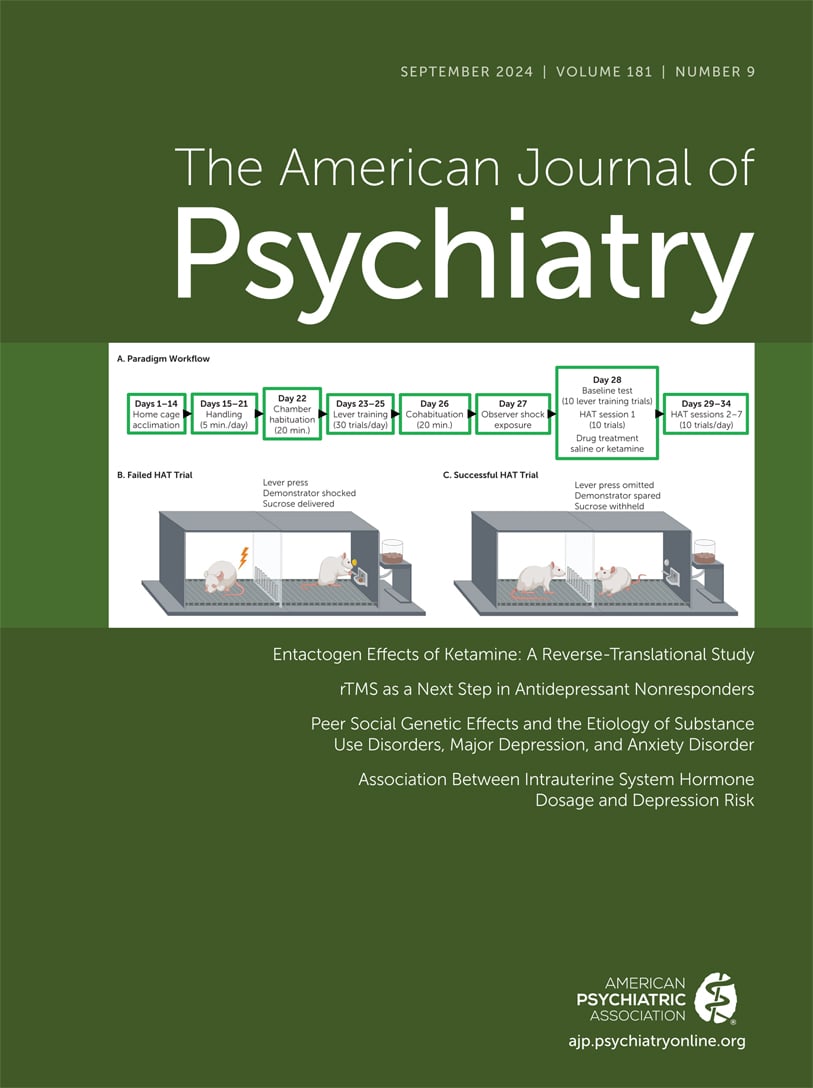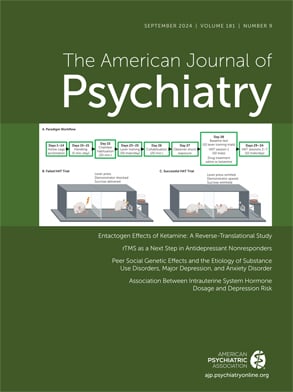The development of novel interventions for depression has all too often ignored the needs of end users, including patients, policy makers, and frontline health care professionals (
1). We have many interventions for treatment-resistant depression (TRD), the efficacy of which are no longer in doubt. Augmentation and switch pharmacotherapy (
2), psychotherapy (
3), electroconvulsive therapy (ECT) (
4), and, more recently, repetitive transcranial magnetic stimulation (rTMS) are all interventions with established evidence of efficacy in TRD (
5). Today the uncertainty is no longer whether or not these interventions are effective but rather which intervention to choose and when, which often requires large-scale comparative effectiveness studies (
6).
The seminal comparative effectiveness study about which intervention to choose and when that has guided patient and physician decision making in TRD for the last 20 years is the Sequenced Treatment Alternatives to Relieve Depression (STAR*D) study (
7). Among its many findings, STAR*D demonstrated that even with rigorous structured pharmacological and psychological treatment, it was difficult to achieve remission in TRD despite multiple treatment trials (
8).
Since STAR*D was published in 2006, we have emerged from an era of stagnation with no new treatments for depression to an era of rapid progress of new and meaningful interventions for the clinical care of patients with TRD. It has even reached the point that some authors have put forward the call for conducting an updated STAR*D (
9). Advancements in the treatment of TRD since STAR*D include atypical antipsychotic augmentation (
10), the approval of intranasal esketamine (
11), the growing use of intravenous ketamine at subanesthetic doses (
12), the explosion of interest in the use of psychedelic interventions such as psilocybin (
13,
14), and, as it pertains to the current issue of the
Journal, the use of rTMS (
5,
15). Individually, each of these interventions now plays an important role in the care of patients, while collectively, these approaches represent a fundamental shift in the delivery of care for patients with TRD. However, of all of these new interventions, rTMS is arguably the most important advancement in the management of TRD not only because of its demonstrated efficacy but also due to advances in our neuroscience-based tools that hold promise to optimize rTMS treatment outcomes (
16,
17) and personalize the intervention to each individual patient’s underlying pathophysiology (
18).
rTMS is an intervention that encompasses a broad parameter space that includes different patterns and locations of stimulation. It is a noninvasive approach that delivers repetitive magnetic field pulses to modulate neural firing in local and distant brain circuits. The treatment was approved by the FDA in 2008 for TRD and has repeatedly been demonstrated to be safe, tolerable, and effective (
5). Side effects are generally minimal and consist of local scalp discomfort and headache. The worst side effect of seizure is exceedingly rare and less common than seizures associated with pharmacotherapy (
19). While some have questioned its effectiveness (
20), rTMS has repeatedly been shown to be superior to sham or placebo procedures and cost-effective compared to pharmacotherapy (
5,
21). The FDA clearance in 2018 of a more efficient form of rTMS, called intermittent theta burst stimulation (iTBS), using a comparative effectiveness clinical trial design has greatly increased the scale and availability of this treatment (
15,
22). Although challenges remain for providing this treatment in nonurban settings, a topic that requires further work and creative implementation models, access to rTMS as an effective evidence-based treatment has been dramatically improved. As a result, the outstanding question of today is no longer whether rTMS is effective compared with a sham condition but rather how it compares to alternative treatment options and when it should be offered in a sequential treatment algorithm of TRD. Therefore, clinical research needs to focus on patient priorities and determine the relative effectiveness of various interventions—medication optimization versus rTMS, esketamine versus rTMS, intravenous ketamine versus rTMS—through “strategic, head-to-head phase 3 studies” (
23).
The current issue of the
Journal reports the results of just such a study by Dalhuisen et al. (
24) from the Netherlands. This work is an important step in clarifying the position of rTMS within the sequential treatment algorithm of TRD. In this study, 89 participants—all of whom had an inadequate response to at least two treatment trials—were randomly assigned to one of two arms: algorithm-based medication treatment or an evidence-based rTMS treatment protocol. Both treatment arms received concurrent psychotherapy. The authors found a statistically and clinically significant effect strongly favoring rTMS over medications, with a standardized effect size of 0.77 on the Hamilton Depression Rating Scale. From a patient-focused point of view, the authors found that for every five patients treated with rTMS (versus medication), one more person achieved remission, for a number needed to treat of five. The tolerability of rTMS was excellent, with only one of 48 participants dropping out because of side effects. This study suggests, quite convincingly, that for individuals who have not responded to two or more medications, treatment with rTMS as opposed to another medication trial is significantly more likely to achieve remission of their depressive symptoms, which is the ultimate goal of treatment (
25).
The context of these findings is also important, as they coincide with the recently published ASCERTAIN-TRD, a North American-based comparative effectiveness trial in which individuals with TRD were randomly assigned to one of three arms: switch to extended-release venlafaxine, augmentation with aripiprazole, or treatment with rTMS (
26). The ASCERTAIN-TRD study, although falling short of its recruitment target, demonstrated that rTMS was significantly more effective than medication switch and achieved numerically greater rates of response and remission compared with aripiprazole augmentation (
26).
The results of Dalhuisen et al. and ASCERTAIN-TRD both suggest that improved outcomes can be achieved through treatment with rTMS compared with pharmacotherapy. They also provide emerging evidence about the role of rTMS in the care of those suffering from TRD, suggesting that implementation of evidence-based rTMS should be considered earlier in the sequential treatment algorithm. This is supported by secondary analyses of large-scale rTMS clinical trials, which found that fewer antidepressant treatment failures are associated with improved remission rates (
27,
28). It therefore may be possible to use rTMS earlier to achieve remission faster and for more patients suffering from TRD.
However, we need to carefully consider the positioning of rTMS within a sequential treatment algorithm for depression. Although some have suggested that rTMS (potentially in an accelerated format) be compared alongside ECT in a sequential treatment algorithm for depression (
9), the current state of the evidence suggests that rTMS—given its superior tolerability (
29)—should be positioned earlier in the treatment algorithm. Although there are ongoing uncertainties regarding the exact positioning of rTMS within a sequential treatment algorithm of TRD, the study by Dalhuisen et al. provides important knowledge both for immediate shared patient and physician decision making and for the long-term design of large-scale comparative effectiveness trials focusing on the needs and priorities of patients.

